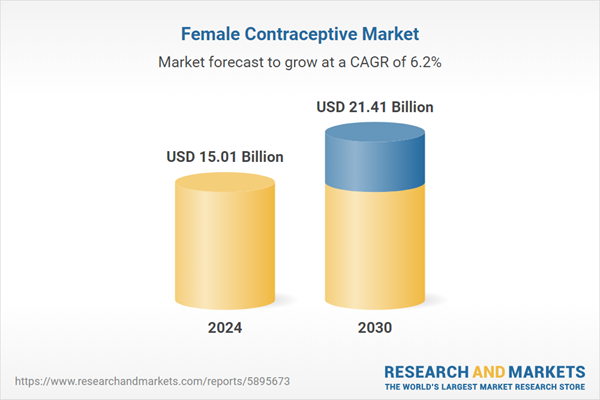Speak directly to the analyst to clarify any post sales queries you may have.
10% Free customizationThis report comes with 10% free customization, enabling you to add data that meets your specific business needs.
The sector plays a key role in family planning, reducing maternal mortality, and supporting women’s health globally. Growing awareness about reproductive health, increased healthcare accessibility, supportive government initiatives, and evolving social norms are propelling demand. According to the UNFPA’s 2022 report, nearly 121 million unintended pregnancies occur globally each year, highlighting the critical need for effective contraceptive solutions. Innovation in product development and shifting cultural attitudes continue to strengthen market expansion worldwide.
Key Market Drivers
Women’s Empowerment
Women’s empowerment is a major catalyst for growth in the female contraceptive market, influencing healthcare decision-making and reproductive autonomy. Educated and informed women are better equipped to make decisions regarding contraception that align with their health needs and personal circumstances. Greater empowerment improves access to healthcare services, prompting more women to utilize family planning clinics and seek out reliable contraceptive options. As economic independence grows, women are increasingly able to afford and prioritize contraceptive products and services. This economic and social empowerment drives demand, encouraging pharmaceutical companies to innovate and expand contraceptive offerings to meet diverse needs across different populations.Key Market Challenges
Limited Access and Awareness
Limited access to and awareness of contraceptive options remains a major barrier in the global female contraceptive market, particularly in underprivileged and rural areas. Many women face financial, cultural, or geographic constraints that prevent them from obtaining reliable contraceptives. A lack of education and knowledge about available methods also contributes to low adoption rates. Addressing this challenge requires coordinated efforts by governments, NGOs, and international health organizations to expand education campaigns and improve access to family planning services. By empowering women with accurate information and affordable options, these initiatives aim to reduce disparities and foster informed reproductive choices.Key Market Trends
Hormonal Contraceptives with Reduced Side Effects
A significant trend shaping the female contraceptive market is the development of hormonal contraceptives designed to minimize side effects. Manufacturers are investing in research to produce solutions that effectively prevent pregnancy while reducing issues such as mood changes, weight gain, and reduced libido. These innovations aim to enhance the user experience, making hormonal contraceptives more appealing and acceptable to a broader population. As awareness of long-term reproductive health grows, demand for safer, user-friendly options is driving the evolution of new-generation hormonal contraceptives with improved tolerability and efficacy.Key Market Players
- Bayer AG
- Mayer Laboratories Inc
- Pfizer Inc
- Mylan Pharmaceuticals Inc
- Teva Pharmaceutical Industries Ltd
- Organon & Co.
- Agile Therapeutics Inc
- Lupin Pharmaceuticals Inc
- The Female Health Company
- FUJI LATEX CO.LTD.
Report Scope:
In this report, the Global Female Contraceptive Market has been segmented into the following categories, in addition to the industry trends which have also been detailed below:Female Contraceptive Market, By Contraceptive Drugs:
- Oral Contraceptives
- Contraceptive Injections
- Topical Contraceptives
- Spermicides
Female Contraceptive Market, By Device:
- Female Condoms
- Diaphragms and Caps
- Vaginal Rings
- Contraceptive Sponges
- Sub-dermal Contraceptive Implants
- Intra Uterine Contraceptive Devices (IUCDs)
- Others
Female Contraceptive Market, By Region:
- North America
- United States
- Canada
- Mexico
- Europe
- Germany
- United Kingdom
- France
- Italy
- Spain
- Asia-Pacific
- China
- Japan
- India
- Australia
- South Korea
- South America
- Brazil
- Argentina
- Colombia
- Middle East & Africa
- South Africa
- Saudi Arabia
- UAE
Competitive Landscape
Company Profiles: Detailed analysis of the major companies present in the Global Female Contraceptive Market.Available Customizations:
With the given market data, the publisher offers customizations according to a company's specific needs. The following customization options are available for the report.Company Information
- Detailed analysis and profiling of additional market players (up to five).
This product will be delivered within 1-3 business days.
Table of Contents
Companies Mentioned
- Bayer AG
- Mayer Laboratories Inc
- Pfizer Inc
- Mylan Pharmaceuticals Inc
- Teva Pharmaceutical Industries Ltd
- Organon & Co.
- Agile Therapeutics Inc
- Lupin Pharmaceuticals Inc
- The Female Health Company
- FUJI LATEX CO.LTD.
Table Information
| Report Attribute | Details |
|---|---|
| No. of Pages | 186 |
| Published | July 2025 |
| Forecast Period | 2024 - 2030 |
| Estimated Market Value ( USD | $ 15.01 Billion |
| Forecasted Market Value ( USD | $ 21.41 Billion |
| Compound Annual Growth Rate | 6.2% |
| Regions Covered | Global |
| No. of Companies Mentioned | 10 |









